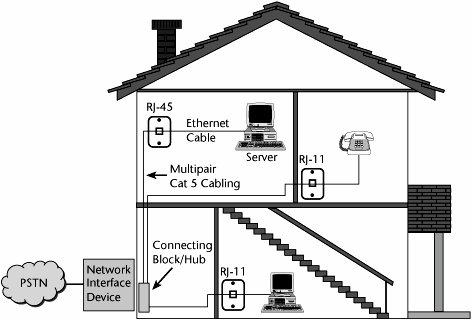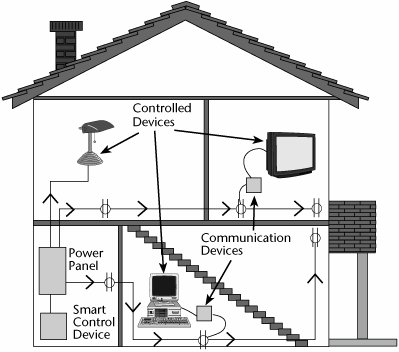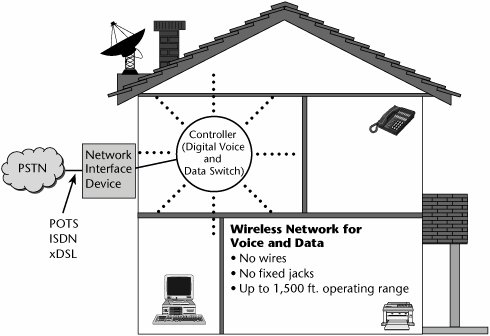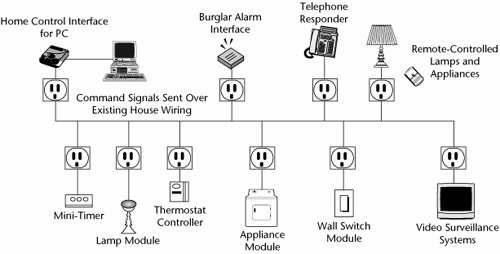HANs
Smart devices, such as the many devices discussed in this book's introduction, need channels over which to communicate, so the more computers, communications devices, entertainment vehicles, and intelligent appliances and accessories present in a home (such as home automation or security tools), the greater the likelihood that they all need a home networka HANover which to exchange information in order to realize their true value.
The emergence of intelligent appliances also opens up an entirely new level of market involvement. It creates a new outlet for knowledge, content, and information services that can be offered by online experts and service providers. A smart appliance acts as a vehicle for stimulating interest in activities that benefit from using the appliance. In essence, the appliance becomes a part of a collaborative system that satisfies a much higher human need. Basically, a smart device needs a reason to exist, and that reason is a continually developing set of applications and services with which to better our lives. It is therefore important to look beyond the last mile and at technologies that apply in home area networking.
The HAN Market, Applications, and Elements
Broadband deployments are accelerating. As of early 2006, on the order of 200 million broadband access lines had been deployed worldwide. Traditionally, broadband deployments have focused on core networks and on the last mile (i.e., the local loop). But the last mile is really only half of the broadband solution. Simplicity and user-friendliness are driving rapid penetration of intelligence into all the various home elements. The HANwhich is the last 330 feet (100 m)brings the broadband access solution closer to completion. (Ultimately, broadband access will need to extend to the individualthe domain of PANsand then right into the individualthe realm of intelligent implants, as discussed in the introduction.) Therefore, we can expect to see the global market for home networking equipment rise substantially. Many expect the home data and entertainment networking market as well as the connectivity services market to be worth billions of dollars. Connectivity products will offer additional voice management, home monitoring, and entertainment services. The service provider will begin to move its area of domain into the home, offering broadband access along with home area networking technology, smart appliances, and bundled applications. Service providers today see the home network as a competitive necessity as well as a source of revenue. In fact, the home network is now considered part of the service provider network.
Home networking is substantially different from enterprise networking. The traffic patterns are different, the applications are different, and the transmission media available to carry the information are different. Home users, whether consumer or professional users, will need to network computers and peripherals, and they will need a residential gateway to access their broadband connection and allow it to be shared among multiple devices. They will also want additional services, such as VoIP, support for interactive multiplayer games, and streaming entertainment media. Although new homes are increasingly wired with Cat 5 cable or fiber, most existing homes are not. The most common choices for HAN media are generally phone lines, powerlines, and wireless technologies. As discussed shortly, each presents a unique set of advantages and disadvantages.
We will certainly be developing quite a complex HAN infrastructure, which might include the components shown in Figure 12.10. The product range includes transceivers or communications interfaces, network interface cards for the various devices participating on the network, gateways, servers, sensors, controllers, and some form of operating system. A variety of broadband servicesincluding DSL, coax cable, fiber, wireless, and hybrid arrangementsare all possible. Those services will terminate on the home network gateway, which will connect to some form of a communications hub, a residential gateway device that can then split the signals and deliver them to the proper receivers. From the residential gateway there will then be several different networks. The automation and control network may include the various sensors that help automate the home to make life easier and happier. Mobility networks will be wireless networks that allow a user to roam within the range of a home and the outdoor area surrounding it.
Figure 12.10. Home networking elements

Computer interconnection is one of the major applications of HANs. It allows access to the Internet and the connection and communication of multiple PCs with various peripherals and communications and entertainment devices. This computer connection requires very high-speed networks. Generally, homes with two or more computers are considered to be prime candidates for this type of HAN. In addition, controlling the homeincluding managing lights, appliances, climate control systems, and surveillance cameraswill be a huge market for HANs.
Types of HANs
Several different technologies can be applied in HANs. The home network is likely to become a layered network, just like the enterprise network, where there's a need for backbone networks, mobility networks, control networks, and wired networks, each of which is best served by one or another alternative. The success of HANs depends on standard products that are operable with a variety of physical infrastructures, so we'll see the use of voice-grade telephony wiring, coax, electric powerlines, wireless, and fiber. The wireless approach has by far the greatest penetration today, using the popular Wi-Fi standard for wireless LANs.
HANs over Phone Lines
One approach to HANs is the use of existing phone lines (see Figure 12.11). The Home Phone Networking Alliance (HomePNA; www.homepna.org) is a major interest group in this space. HomePNA, which is composed of more than 150 companies, is an incorporated nonprofit association, and more than 25% of it member companies are outside the United States. HomePNA's main objective is to work toward establishing and ensuring compatibility with standards among telecom, computer, and network products. Although HomePNA does not enforce standards, it does advise the ITU-T. And although it does not actually manufacture any products, it does endorse products as being HomePNA certified.
Figure 12.11. A HAN over phone lines

HomePNA develops triple-play HAN solutions, supporting multimedia home networking services, such as VoIP, data, and SDTV/HDTV, over existing phone or coax lines. The technology provides data rates up to 240Mbps, with guaranteed QoS, enabling service providers to support multimedia services in the home, including in-home distribution of broadcast IPTV and networked PVRs.
The HomePNA specification has been through several versions. The most current is HomePNA 3.0. (The 2.0 version was approved by the ITU-T as a global standard and is formally known as Recommendation G.989.1, with subsequent upgrades to G.989.2 and G.989.3.) HomePNA 3.0, announced in 2003, allows the networking of home computers over what looks like a LAN, using existing telephone or coax wiring. Given this capability, multiple computers can share Internet access and access to various peripherals (such as printers or storage devices), files, or multiplayer games without the need for a router. HomePNA 3.0 makes use of different frequencies for the data streams than for the basic phone traffic. A frequency reserved and prioritized for phone and fax calls allows them to take precedence over any other data communications. HomePNA 3.0, standardized by the ITU-T as G.9954, has been selected by major service providers in North America and Europe. A number of companies have working products moving toward production, and manufacturers are demonstrating gateways, set-top boxes, and devices with embedded interfaces.
HANs over Powerlines
Figure 12.12 shows an example of a powerline HAN. The main advantage of the powerline approach to home area networking is that it's an ideal architecture for data networks because the majority of devices must connect to a power source in order to operate in the first place. Another advantage is that, as with phone lines, no RF conversion hardware is necessary, so the cost can be lower than that of wireless solutions. However, powerlines are considered to be a harsh environment for communications, and that is the main disadvantage of this method.
Figure 12.12. A powerline HAN

In the home network scenario, there are likely to be many stubs with terminating loads of various impedances. At some frequencies, the transmitted signal may arrive at the receiver with little loss, while at others, it may be very noisy. Typical sources of noise are dimmer switches, switching power supplies, brush motors, and halogen and fluorescent lamps. In addition, the conditions on the powerline change, for instance, as users plug in new devices. This means that the nature of the channel between outlets may vary a great deal, resulting in differences in the quality of transmission as well as the amount of bandwidth available to carry data.
Another issue is that the flexibility of a PLT HAN depends on the availability and placement of the power sources. Another important consideration is the topology of the power distribution to the home. In the United States, a distribution transformer provides power to a small number of homes (8 to 10). While the distribution transformer does a good job of blocking the powerline networking signals from crossing into the main power grid, it does not prevent signals from crossing between homes powered by the same distribution transformer. This means that the networking signals from your home could show up on the powerline in any of the other homes served by the same source, creating privacy and security concerns similar to those experienced with wireless networks. In order to provide a reliable communications channel over powerline, the proposed solution must include both robust physical layer (PHY) specifications and an efficient MAC protocol. Again, the PHY defines the basic packet formats, coding, and modulation, and the MAC protocol controls how multiple clients share the medium.
The HomePlug Powerline Alliance (www.homeplug.com) plays a critical role with its global HomePlug standard for PLT. HomePlug-certified products connect computers and peripherals that use Ethernet, USB, and IEEE 802.11. The HomePlug Powerline Alliance certifies products for HomgPlug compliance so that devices carrying its certification mark are interoperable. There are two versions of HomePlug:
- HomePlug 1.0 HomePlug 1.0 enables speed up to 14Mbps.
- HomePlug 2.0 Also known as HomePlug AV, HomePlug 2.0 promises a raw data rate of up to 200Mbps, although the practical throughput is closer to 100Mbps. This new standard, while compatible with HomePlug 1.0, can support VoIP and HDTV.
The alliance is also now working on a HomePlug BPL standard.
Through the use of OFDM modulation, which allows coexistence of several distinct data carriers in the same wire pair, HomePlug brings back the ability to use Ethernet in a bus topology. To deal with the noise problems inherent in the powerline medium, the HomePlug technology uses OFDM as the basic transmission technique. (OFDM, which is widely used in DSL technology and in numerous wireless systems, is discussed in Chapter 13.) It also makes use of a combination of sophisticated forward error correction (FEC), interleaving, error detection, and automatic repeat request (ARQ) to ensure that the channel appears reliable to the network-layer protocols.
A nonprofit organization called the Consumer Electronics Powerline Communication Alliance (CEPCA; www.cepca.org) has been formed by Sony (www.sony.com), Mitsubishi (www.mitsubishi.com), and Panasonic (www.panasonic.com). A company with a global effort, CEPCA's main mission is to promote and continuously advance high-speed PLT technology to use and implement a new generation of consumer electronics products through the rapid, broad, and open industry adoption of CEPCA specifications. It is important to note that the alliance's main purpose is to promote coexistence rather than to develop a specific technology; in fact, the founders are currently making use of four or more technologies. CEPCA will be working on promoting coexistence in the United States, Europe, and China and encouraging PLT deregulation in Japan while also submitting proposals to the IEEE, ETSI PLT, and PLC-J (in Japan).
In January 2006, Panasonic debuted its new HD-PLC Ethernet adapter, which supports up to 190Mbps data speed over a range of 500 feet (150 m). HD-PLC makes it possible to connect, over one unified network, high-definition video content, music playback, Internet gaming, VoIP phone service, color video monitoring, and computers and peripherals. The new adapter also addresses security, automatically setting AES 128-bit encryption with the push of a setup button on each unit. To address the noise and interference issues present in the powerline medium, HD-PLC uses OFDM and sophisticated error control to ensure the highest-quality transmission and reliability in the face of noise and interference. Quite a few other players are also creating hardware PLT HAN devices.
Another PLT standard is X10 Ltd.'s (www.x10.com) standard X10. X10 is a communications protocol for remote control of electrical devices and communications over standard household AC powerline wiring (with off, on, and dim functions). Manufacturers of home appliances can design and embed X10 transmitters in them, and the receiving and control devices are made by X10 Ltd. itself.
The Consumer Electronic Bus (CEBus) home networking standard is for multiple alternatives, including powerlines. The CEBus effort began in 1984, when members of the EIA identified a need for standards that included more than on, off, dim, bright, all lights on, and all units off controls. After six years of meeting on a regular basis, the engineers proposed the CEBus standard. The standard was released in 1992, presenting an open architecture set of specification documents that define protocols for how to make products communicate through powerline wires, low-voltage twisted-pair, coax, infrared, RF, and fiber. Presently, the CEBus communications hardware, language, and protocol are available on a chip produced by Intellon Corporation (www.intellon.com). Having moved out of the laboratory and into the market, the CEBus trademark is now owned by the EIA. Ongoing developments are being conducted by the CEBus Industry Council (www.cebus.org), a nonprofit organization made up of representatives of many national and international electronics firms, such as Microsoft (www.microsoft.com), IBM (www.ibm.com), Honeywell (www.honeywell.com), Panasonic (www.panasonic.com), and Sony (www.sony.com).
Wireless HANs
Figure 12.13 shows an example of a wireless HAN. Wireless HANs have advantages as well as disadvantages. The main advantage of a wireless HAN is that it provides an untethered solution for devices that need mobility in communications. I adore my wireless LAN, specifically for that reason. I can take my work where I want it, within my grounds, and not worry about being near a phone jack, although a power connection is a consideration.
Figure 12.13. A wireless HAN

One disadvantage is that a multitude of standards address wireless HANs, including the following:
- 802.11 IEEE 802.11, Wi-Fi, originally supported 1Mbps to 2Mbps, in the 2.4GHz range. The IEEE has since published three supplements to the 802.11 standard: 802.11a (55Mbps in the 5GHz band, with actual throughput closer to 27Mbps), 802.11b (11Mbps in the 2.4GHz band, with actual throughput closer to 5.5Mbps), and 802.11g (55Mbps in the 5GHz band, with actual throughput closer to 27Mbps). The greatest advantage of Wi-Fi is its simplicity. You can connect computers anywhere in the home or office without the need for wires. The 802.11 and other short-range wireless technologies are discussed in detail in Chapter 15.
- Bluetooth The Bluetooth Consortium (www.bluetooth.com) deals with networks that operate over very short ranges (about 100 feet [30 m]), but more and more devices are being created to work in these ranges. Approximately 2,500 manufacturers have signed up to incorporate Bluetooth into their products, which is a very important step in the growth of wireless. (Chapter 15 discusses the details of Bluetooth.)
Another disadvantage of wireless HANs is that generally, depending on the type of wireless network or standard selected, there may be bandwidth limitations. But more importantly, wireless also has unresolved security issues, network infringement issues, interference from other wireless sources, and various performance issues. (Chapter 13 discusses wireless behavior, and Chapter 15 describes the wireless communication standards applicable to home area networking in more detail.)
Control Networks
Control networks are typically low-speed powerline networks (see Figure 12.14). The most widely used technologies for home automation and control purposes are based on three standards:
- LonWorks Echelon Corporation's LonWorks (www.lonworks.com) is an open standard under EIA 709 that provides a solution to the many problems of designing, building, installing, and maintaining control networks. LonWorks networks can range in size from 2 to 32,000 devices and can be used in everything from supermarkets to petroleum plants, aircraft to railway cars, fusion lasers to slot machines, single-family homes to skyscrapers. The trend now is to move away from proprietary control schemes and centralized systems to open, off-the-shelf chips, operating systems, and parts to build products. The LonWorks protocol is now embedded in silicon neuron chips from Cypress Semiconductor (www.cypress.com), Toshiba America (www.toshiba.com), and other companies. Dozens of manufacturers are incorporating these chips into their modules for controlling household electrical equipment, providing interoperability, robust technology, faster development, and scale economics.
- X10 As mentioned earlier in this chapter, X10 is a communications protocol for remote control of electrical devices and communications over standard household AC powerline wiring (with off, on, and dim functions). X10 Ltd. publishes the specifications, manufacturers can embed the transmitters into their appliances, and X10 Ltd. manufactures and sells the receiving and control devices.
- CEBus CEBus, as discussed earlier in this chapter, is an open standard that specifies the technology and parameters for communications using powerlines, Cat 5 twisted-pair, coax, wireless, and infrared. It is based on EIA 600.
Figure 12.14. A control network

Advantages of control networks include the fact that there are existing product solutions and well-established industry standards. Control networks also have relatively low cost and simple implementation. The disadvantage is that these networks are not designed to support real-time, high-bandwidth, or mobility requirements, so the value proposition of standalone applications does not offer the incentives for the mainstream market to consume the products.
Wired HANs
Wired HANs include Universal Serial Bus (USB), Category 5 or 10BASE-T wiring, and IEEE 1394 (FireWire). The benefits of wired HANs are that wired network standards are reliable and robust. The drawbacks of wired networks are that penetrating the mass market requires a "no new wires" technology. These solutions, therefore, will primarily extend only to new homes that are making use of structured wiring and perhaps to the technophile hobbyist and professional home user market.
HAN Gateways and Servers
A HAN requires a system for identifying data and routing it to its destination, and this implies the need for gateways and servers. A residential gateway connects a HAN to the Internet. A hardware device similar in appearance to a router, it provides many features necessary in a HAN. Most residential gateways support at least the basic features of broadband connectivity (usually through DSL or cable modems), sharing of the Internet connection, and firewall security. In addition, as we progress toward support of advanced multimedia applications, the residential gateway will also interact with the home telephone, entertainment systems, kitchen and home appliances, and the entire new generation of network-enabled devices.
At this point, gateway products are in their early stages, and the technical standards are therefore evolving. One important standard is CableLabs CableHome, which has two specifications:
- CableHome 1.0 The CableHome 1.0 specification achieved international standardization in 2002 as ITU document J.191. CableHome 1.0 provides for handoff, authentication, and provisioning of the gateway; secure remote management and configuration; home device visibility and connectivity tests; cable and application-friendly address translation; protection of the cable network from in-home traffic; firewall management and rule set downloading; and local name service.
- CableHome 1.1 In 2004, the CableHome 1.1 specification also gained international standardization, as the ITU-approved document J.192. CableHome 1.1 introduced features requested by cable operators, allowing them to enhance their home networking service offerings. CableHome 1.1 improves on the features available in CableHome 1.0 and adds gateway security features; standardized prioritized QoS for HANs; support for home servers, teleworkers, and home offices; simple parental control; and LAN management messaging and LAN IP statistics monitoring.
Planning for the Future of HANs
HANs are becoming a fundamental aspect of a person's residence, and they will become more functional and important as we go forward into the realm of interactive and mobile multimedia lifestyles. In considering HANs, it is important to plan for the future. You need to plan and install an infrastructure designed to address today's needs, and you also need to understand that tomorrow you will need to support much more advanced applications and a greater range of devices. It is a good idea to stay away from permanent equipment that will become obsolete soon. You should try not to choose products that limit your ability to change or upgrade in the future, and you should try to ensure that the infrastructure stays invisible.
You should consider a number of other points going forward, as more and more intelligence surrounds you and becomes self-aware in an attempt to serve you even better:
- Who is in control in the smart house?
- Does the house's behavior act consistently with the image you would like to project?
- Does the house now have a personality of its own?
- What happens when the power goes off? More importantly, what happens when the house crashes? Do you get locked in forever?
These are issues we will resolve in time. Security is going to be quite important to all of this, and although security solutions do not abound, there has been significant progress in the areas of encryption, authentication, and key exchange. Much additional development is being done in this area, including the use of biometrics.
Part I: Communications Fundamentals
Telecommunications Technology Fundamentals
- Telecommunications Technology Fundamentals
- Transmission Lines
- Types of Network Connections
- The Electromagnetic Spectrum and Bandwidth
- Analog and Digital Transmission
- Multiplexing
- Political and Regulatory Forces in Telecommunications
Traditional Transmission Media
Establishing Communications Channels
- Establishing Communications Channels
- Establishing Connections: Networking Modes and Switching Modes
- The PSTN Versus the Internet
The PSTN
- The PSTN
- The PSTN Infrastructure
- The Transport Network Infrastructure
- Signaling Systems
- Intelligent Networks
- SS7 and Next-Generation Networks
Part II: Data Networking and the Internet
Data Communications Basics
- Data Communications Basics
- The Evolution of Data Communications
- Data Flow
- The OSI Reference Model and the TCP/IP Reference Model
Local Area Networking
Wide Area Networking
The Internet and IP Infrastructures
- The Internet and IP Infrastructures
- Internet Basics
- Internet Addressing and Address Resolution
- The Organization of the Internet
- IP QoS
- Whats Next on the Internet
Part III: The New Generation of Networks
IP Services
Next-Generation Networks
- Next-Generation Networks
- The Broadband Evolution
- Multimedia Networking Requirements
- The Broadband Infrastructure
- Next-Generation Networks and Convergence
- The Next-Generation Network Infrastructure
Optical Networking
- Optical Networking
- Optical Networking Today and Tomorrow
- End-to-End Optical Networking
- The Optical Edge
- The Optical Core: Overlay Versus Peer-to-Peer Networking Models
- The IP+Optical Control Plane
- The Migration to Optical Networking
Broadband Access Alternatives
- Broadband Access Alternatives
- Drivers of Broadband Access
- DSL Technology
- Cable TV Networks
- Fiber Solutions
- Wireless Broadband
- Broadband PLT
- HANs
Part IV: Wireless Communications
Wireless Communications Basics
- Wireless Communications Basics
- A Brief History of Wireless Telecommunications
- Wireless Communications Regulations Issues
- Wireless Impairments
- Antennas
- Wireless Bandwidth
- Wireless Signal Modulation
- Spectrum Utilization
Wireless WANs
- Wireless WANs
- 1G: Analog Transmission
- 2G: Digital Cellular Radio
- 5G: Enhanced Data Services
- 3G: Moving Toward Broadband Wireless
- Beyond 3G
- 4G: Wireless Broadband
- 5G: Intelligent Technologies
WMANs, WLANs, and WPANs
Emerging Wireless Applications
- Emerging Wireless Applications
- The Handset Revolution
- Mobile IP
- The IP Multimedia Subsystem
- Mobile Gaming
- Mobile Video
- Mobile TV
- Mobile Content
Glossary
EAN: 2147483647
Pages: 160
